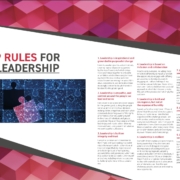Don’t Ignore Virtual Teamwork
Biz Ed November/December 2010, pp. 54-55
While most business educators agree that students need to master the dynamics of successful teamwork, fewer are convinced of the importance of virtual teamwork. First, most educators assume the frameworks they teach in face-to-face leadership courses are equally valid for online groups. And second, practitioners are still in the experimental phase of using virtual teamwork, so they’re hesitant to declare any conclusions on the topic.However, virtual teamwork will be a critical function in the 21st-century workforce—in fact, all of the students in our Emerging LeadersProgramme (ELP) at the LondonBusiness school either currently work in at least one virtual team or anticipate doing so in the next five years. For that reason, we have developed approaches that focus on virtual teamwork, both in the classroom and in practical application.
Putting ‘Virtual’ to the Test
We have integrated a virtual emphasis into the ELP by highlighting existing applicable content and adding lessons that teach explicitly how to manage virtual teams. For instance, we added a virtual simulation that reinforces the program’s core themes of marketing, strategy, and teamwork.Recently, we also experimented with requiring students to complete a competitive challenge, using both face-to-face and virtual methods.Before students arrived to the pro-gram, we asked them to submit pressing dilemmas that their companies face. We then identified two of these questions as most suitable for students to tackle during the competition. We chose the following questions because they were easily comprehended, did not rely on technical or industry-specific knowledge, and would have a great impact on the business:
1. How could an international news division bring to life its new brand tagline, “Never Stop Asking”?
2. How could newspapers make money selling to a Google generation used to reading content for free?
Students were split into two nine-person teams that incorporated a diverse set of expertise, nationalities, and industries. They had one week to brainstorm and refine solutions to each question. They were allowed—and encouraged—to take advantage of the “wisdom of crowds” by soliciting input from people outside the program.There was one catch: Team A had to answer question No. 1using face-to-face methods only, and question No. 2 using virtual methods only. For Team B, these requirements were reversed. When working virtually, students could use any tools or forums they wished, including video or teleconference, e-mail, or social networking sites. We also constructed a simple custom Web site with the help of virtual consulting company How Might.The site allows teams to post, categorize, rank, and discuss proposed solutions. It also is accessible to external contributors, who can read the question and click through to review the team’s written work. At the end of the week, the teams presented their conclusions to a panel of faculty and course facilitators, who scored the merits of each solution without knowing whether students used face-to-face or virtual methods. After the panel gave its feedback, we discussed what the students found to be the advantages and pitfalls of virtual teamwork, as well as the differences between working virtually and working face-to-face.
What Works, What Doesn’t
This exercise brought to light many things about the nature and requirements of leading a virtual team. In the two parts of our newspaper challenge, for example, our panel found that the quality of solutions did not depend on whether teams used virtual or face-to-face approaches. Instead, other factors played larger roles:
Virtual teams that set too many rules or were too rigid about how and when participants contributed, generally were not as successful as those that were more flexible. Different time zones, for instance, required that teams set slightly longer deadlines.
Virtual teams that produced solutions using customized online team rooms—designed specifically for virtual collaboration—scored better than those that used social networking sites such as Facebook.Social networking sites often offer no function to organize activities effectively, search information, engage in complex discussions, or rank ideas.There is little “click-through” capability. Facebook users either did not participate in brainstorming activities or did so unproductively, perhaps because interactions on the site tend to be largely superficial. The students weren’t accustomed to using it for this purpose. Although virtual teamwork isn’t necessarily more effective than face-to-face teamwork, throughout our courses we have found that virtual teamwork that is well-facilitated and well-supported by the best plat-form for the purpose can be superior to face-to-face interaction, particularly for large or geographically dispersed teams. Once our students return to work, we encourage them to have conversations with theirIT departments about how to create customized team rooms, rather than rely on existing sites with pre-determined features.
A Different Set of Skills
Once students complete their virtual teamwork in our program, they come to several realizations:
Charisma, a traditional leader- ship trait, often doesn’t come through on virtual teams.
Therefore, they must rely not on force of personality, but on clarity, cultural sensitivity, and the ability to delegate. “Lead-ing” in these interactions is less about exhibiting authority and more about emphasizing team accountability, reaching consensus, and being open to challenges.
Merit has more power than personality on virtual teams.
As a result, those who are introverted or are not proficient in the language may thrive on a virtual team. If one of the objectives of great leaders is to bring out the best in everyone, then they should encourage at least some virtual work on very diverse teams.
Technology does not solve every problem.
Virtual teamwork can fail if leaders do not attend to the fundamental problems of coordinating, engaging, and motivating individuals across time zones. It’s easy for team members to disengage when they’re not face-to-face, so students find they must convey a high degree of enthusiasm and clarity, and agree on who is accountable for what, from the start.
Assumptions are dangerous.
If team members are from different cultures, countries, and time zones, leaders cannot assume that everyone shares the same understanding of how the team will work. For example, will everyone be in one virtual“place” at the same time, or will they contribute on their own time? Our students’ most important takeaway is that to lead a virtual team, they must focus on team maintenance before task maintenance
.
Critical to the Curriculum
Attending to the dynamics of virtual teams in the business curriculum can be a challenge. Virtual teams can take more time to form, and they often need more time to complete tasks. To provide that extra time, we explore virtual teamwork during theELP’s intermodular month—which falls between the second and third weeklong modules. At London Business School, we believe it’s critical that students learn to work well on virtual teams. In virtual environments, students must know how to make the transition between succeeding as individuals and succeeding with and through other people. For that reason, we put virtual teamwork near the forefront of all of our lessons on leadership—otherwise, we do not serve our students’ aim to maximize their leadership impact in global business settings.
Adam Kingl is director of the EmergingLeaders Programme at the London Business School in the United Kingdom.













